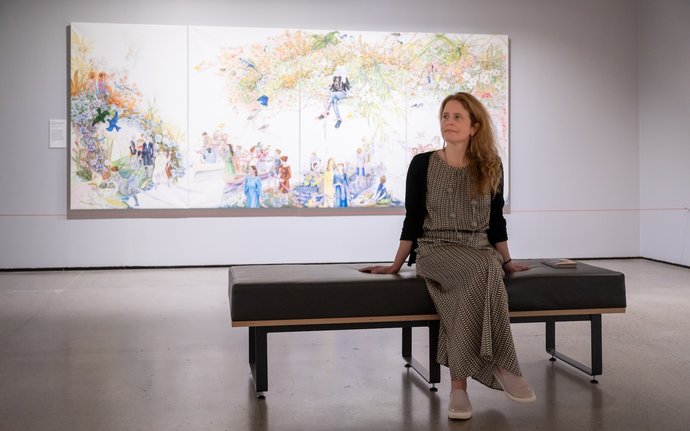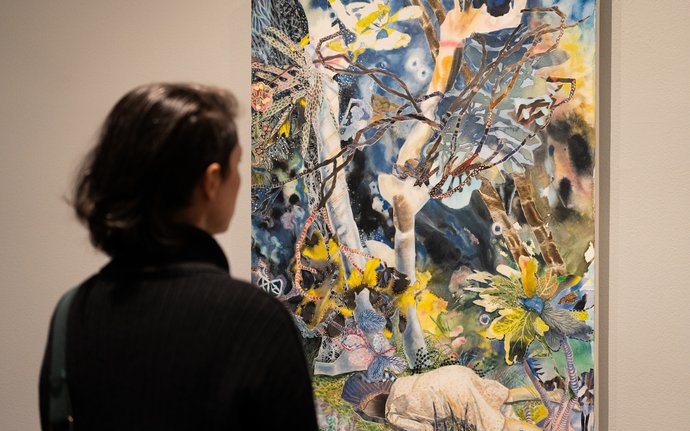Environment natural part of artist Susanne Kerr’s work
15 Jan 2024
This article was first published in The Post, 24 January, 2024.

This article was first published in The Post, 24 January, 2024.

Susanne Kerr is a Wellington painter whose solo exhibition, Remnants, is at Pātaka until 11 February. We asked her about her work.
I’ve been lucky to call Eastbourne home for 17 years and can’t help but be influenced by the regional park that borders it. I go for a bush walk most mornings, when the bird song is the loudest. The cacophony of sound reminds me I am a gate-crasher in this environment.
When I started incorporating the stylised forms of nature in Chinoiserie fabric and wallpaper patterns, it was a natural transition to incorporate the local native birds and flora along with the English gardens from my childhood. It reflects my appreciation for the natural environment. It also references the intermingling of native and introduced species from 200 years of habitation by early settlers. I like to consider the changing nature of our environment and highlight our dependence on it – our need to walk alongside with care.
In these recent works, the figure is overwhelmed and overshadowed by aspects of the natural environment. This is possibly because I see humans from a Darwinian perspective. To date, we have been the most adaptive species on two legs, with the ability to successfully adjust to the changing environment we find ourselves.
While I am part of, and bear witness to, the human psyche of a ‘superiority’ over the natural world, nature remains constant; fragile but quietly resilient and ready to flourish once we vacate. Consciously and subconsciously, I create theatrical sets of the natural environment that make nature the superstars, dwarfing my human characters.
I began cutting up paintings of people to recreate birds out of the shards. I chose to use kitchen scissors and Stanley knives to limit how refined and detailed I could make the cut forms. These small birds reminded me of my repeating dreams of failed flight. They heightened my appreciation of their unique capability of touching earth, sea and sky. The birds were cut and reformed as source material to paint from, but when some mixed-media experiments in the studio started to resemble tree bark, I saw the potential for incorporating them into something bigger.
I enjoy the challenge of a visual puzzle, so piecing these elements together to form something different was an opportunity to see if I could harmoniously resolve all the elements. These jigsaw cut-paintings further evolved into multi-layered cut paintings, joined together at the edges with embroidery thread.
Casting shadows on whatever is beneath their cut forms, they are inspired by nature and the urban environment. The interconnecting lines resemble birds in flight, spider silk, cracks in concrete, microscopic plant patterns and native plant silhouettes.
It refers to all that remains of our natural environment after colonisation, who we are and who we become. It also sums up the ideas, processes, directions not taken, and challenges overcome in the studio to bring this public exhibition together over the last three years.
Characters of all kinds feature in my artworks, but they predominantly involve strong females who direct the narrative from a women’s perspective – exploring the intricacies of social connection and conformity and delving into the unresolved, disquieting moments of being human.
Luscious ribbon-forms weave throughout the theatrical natural environments to envelope human forms, flora and fauna. Like a predator, they bind all that is caught in their path; representing human emotions and actions and referencing our slow, remorseless destruction of the natural environment.
